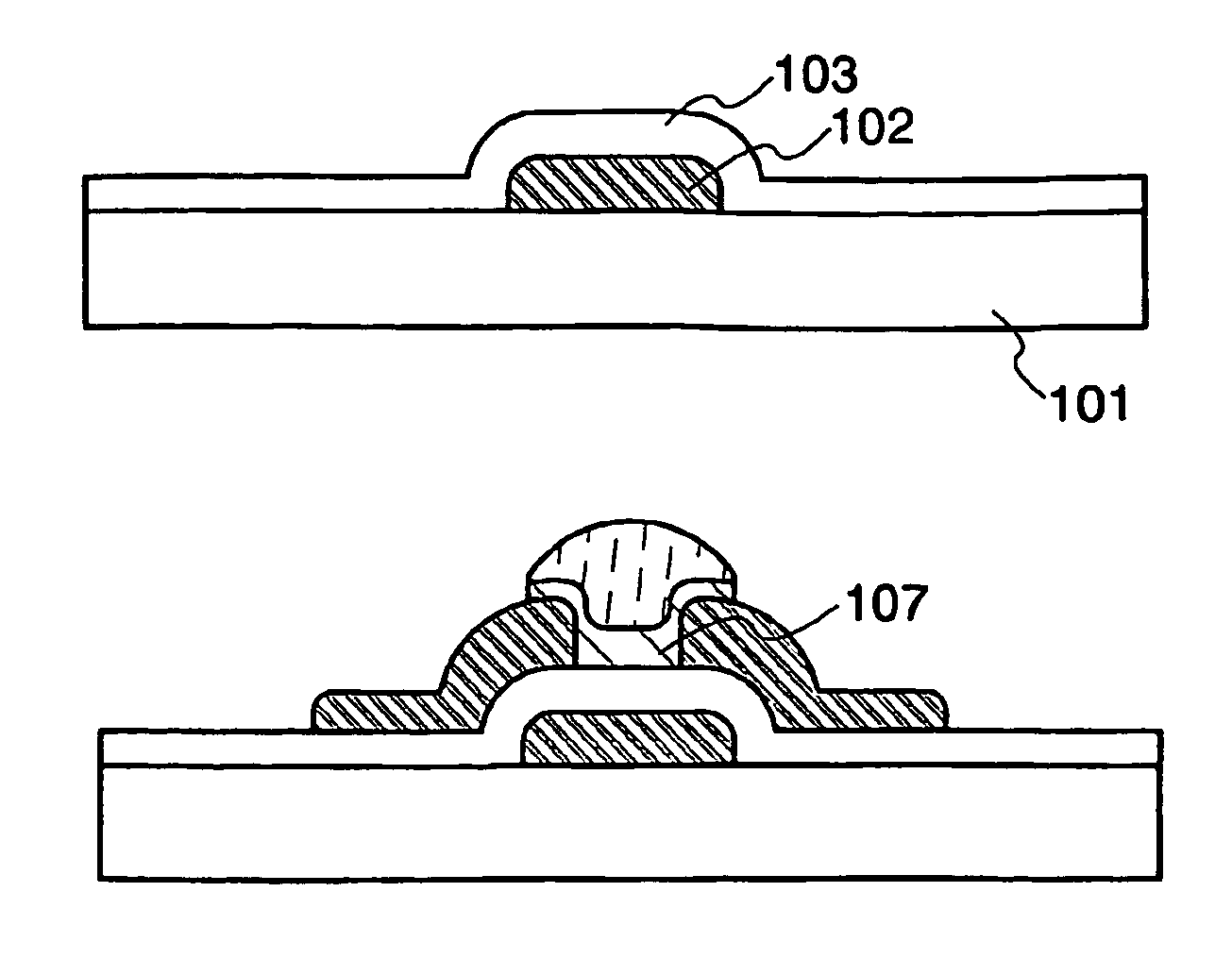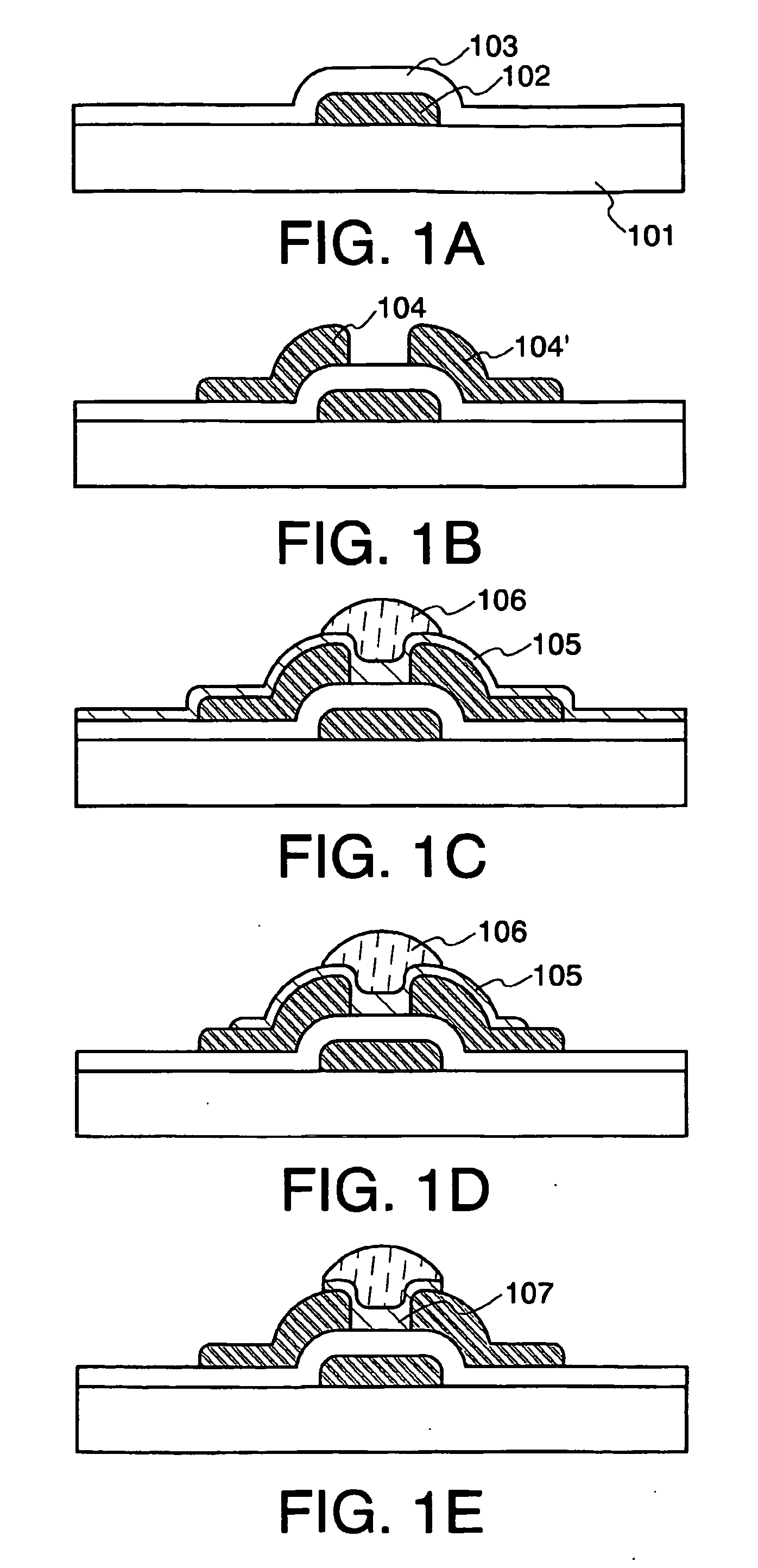Manufacturing method of semiconductor device
a manufacturing method and semiconductor technology, applied in the field of semiconductor devices, can solve problems such as the deterioration of electric characteristics, and achieve the effects of avoiding deterioration of organic tft, high reliability, and simplifying the manufacturing step
- Summary
- Abstract
- Description
- Claims
- Application Information
AI Technical Summary
Benefits of technology
Problems solved by technology
Method used
Image
Examples
embodiment mode 1
(Embodiment Mode 1)
[0031] In this embodiment mode, a manufacturing method of an organic TFT according to the present invention is explained with reference to FIGS. IA to IE.
[0032] A substrate 101 having an insulating surface is prepared as shown in FIG. IA. A glass substrate, a quartz substrate, or a substrate formed from an insulating substance such as alumina can be used as this substrate 101. In addition, a substrate having flexibility may be used, and a substrate comprising one selected from polyethylene terephthalate (PET) polyethylenenaphthalate (PEN), polyethersulfone (PES), polycarbonate (PC), polyimide, and the like may be used.
[0033] Then, a gate electrode 102 of a TFT is formed over the substrate 101 using a material having conductivity by a droplet discharge method, a printing method, an electric field plating method, a PVD (Physical Vapor Deposition) method, a CVD (Chemical Vapor Deposition) method, a vapor deposition method, or the like. The film thickness of the gat...
embodiment mode 2
(Embodiment Mode 2)
[0056] In this embodiment mode, a method for forming a top gate organic TFT is explained with reference to FIGS. 3A to 3D. In FIGS. 3A to 3D, as for the same reference numerals as in Embodiment Mode 1, the material, the forming method, and the like are referred to the description in Embodiment Mode 1.
[0057] Source and drain electrodes 104 and 104′ are formed over a substrate 101. Then, a semiconductor film 105 containing an organic material is formed over the substrate 101 and the source and drain electrodes, and then, a mask 106 is formed so as to be in contact with the semiconductor film 105 (FIGS. 3A and 3B).
[0058] Next, as shown in FIG. 3C, the semiconductor film 105 is patterned using the mask 106 to form a semiconductor layer 107. Subsequently, a gate electrode 102 is formed over the mask 106 in the state where the mask 106 is not removed to remain (FIG. 3D). In this embodiment mode, the mask 106 serves as both a protective film of the semiconductor layer ...
embodiment mode 3
(Embodiment Mode 3)
[0060] In this embodiment mode, a method for forming a first element which is an N type organic TFT and a second element which is a P type organic TFT simultaneously is explained with reference to FIGS. 4A to 4E. In FIGS. 4A to 4E, as for a substrate, a gate electrode, a gate insulating film, source and drain electrodes, a mask, a semiconductor film, a semiconductor layer, and the like having the same reference numerals as in Embodiment Mode 1, the material, the forming method, and the like thereof are referred to the description in Embodiment Mode 1.
[0061] A gate electrode 102a of a first element and a gate electrode 102b of a second element are formed over a substrate 101 in FIG. 4A. Then, a gate insulating film 103 is formed over the gate electrode 102a of the first element and the gate electrode 102b of the second element. Further, source and drain electrodes 104 and 104a′ of the first element, and source and drain electrodes 104b and 104b′ of the second elem...
PUM
 Login to View More
Login to View More Abstract
Description
Claims
Application Information
 Login to View More
Login to View More - R&D
- Intellectual Property
- Life Sciences
- Materials
- Tech Scout
- Unparalleled Data Quality
- Higher Quality Content
- 60% Fewer Hallucinations
Browse by: Latest US Patents, China's latest patents, Technical Efficacy Thesaurus, Application Domain, Technology Topic, Popular Technical Reports.
© 2025 PatSnap. All rights reserved.Legal|Privacy policy|Modern Slavery Act Transparency Statement|Sitemap|About US| Contact US: help@patsnap.com



